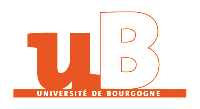Workshop
Algebraic Geometry in Dijon
Algebraic Group Actions
January 16-17, 2023
Institut de Mathématiques de Bourgogne
Program
Research Talks
-
Algebraic torus actions over characteristic zero fields
Abstract
Over an algebraically closed field of characteristic zero, normal affine varieties endowed with an effective torus action were described by Altmann
and Hausen in 2006 by a geometrico-combinatorial presentation. Using Galois descent tools, we extend this presentation to the case where the ground
field is an arbitrary field of characteristic zero. In this context, the acting torus may be non split and may have non-trivial torsors, thus we need additional
data to encode such varieties. We provide some situations where the generalized Altmann-Hausen presentation simplifies. For instance, if the acting torus is split,
we recover mutatis mutandis the original Altmann-Hausen presentation. Finally, we focus on the real setting and on affine varieties endowed
with a two-dimensional torus action. In the latter case we relate the torsor appearing in the generalized Altmann-Hausen presentation to some smooth toric Del Pezzo surface.
-
Nash problem for torus actions of complexity one.
Abstract
Nash problem relates invariants appearing in any resolution of singularities and geometry of arc space of a given algebraic variety.
In a joint work with David Bourqui and Hussein Mourtada, we prove that the Nash problem is affirmative for any non-rational normal
variety with torus action of complexity one. In particular, this holds for most of trinomial hypersurfaces.
-
Empilements de torseurs (Towers of torsors)
Abstract
Le but de cet exposé est de donner une réponse à la question suivante : Étant donnés deux groupes algébriques
lisses et connexes $G$ et $H$, une variété lisse $X$, un $G$-torseur $Y\to X$ et un $H$-torseur $Z\to Y$, peut-on trouver une extension $E$ de $G$ par $H$
telle que la flèche composée $Z\to X$ admette une structure de $E$-torseur ? Cette question est apparue récemment dans divers contextes, mais malheureusement
elle a été traitée à chaque fois de façon "ad hoc". Dans un travail en commun avec Diego Izquierdo et Mathieu Florence,
on a fait une étude systématique de cette question, du moins sur un corps de caractéristique $0$.
On donnera alors dans l'exposé des exemples où la réponse est négative, ainsi que des hypothèses supplémentaires sur les groupes $G$ et $H$ qui
font que la réponse soit positive.
-
On the automorphism group of an affine variety
Abstract
Similarly as the group of linear automorphisms of the affine $n$-space $\mathbb{A}^n$ which is usually denoted by $\mathrm{GL}_n$ plays an important role
in the theory of linear algebraic groups, the group of regular automorphisms of $\mathbb{A}^n$ (or more generally, of an affine variety) should play
an important role in the study of the infinite-dimensional algebraic groups which are usually called ind-groups.
First I will show that the automorphism group of an affine variety (provided it is infinite) is essentially never isomorphic to a linear algebraic group
as an abstract group. Further, I will show that the commutative connected subgroup of the automorphism group $\mathrm{Aut}(X)$ of an affine variety $X$ is
the union of algebraic subgroups of $\mathrm{Aut}(X)$. This allows to characterize maximal commutative subgroups of $\mathrm{Aut}(X)$.
Using this as a tool I will sketch the proof that an affine toric variety is determined by its automorphism group in the category of irreducible affine varieties.
-
Reduction fro branching multiplicities
Abstract
A reduction formula for the branching coefficients of tensor products of representations and more generally restrictions
of representations of a semisimple group to a semisimple subgroup is known. This formula holds when the highest weights of the
representations belong to a codimension 1 face of the Horn cone, which corresponds to a Littlewood-Richardson coefficient equal to $1$.
We prove a similar reduction formula when this coefficient is equal to $2$, and show some properties of the class of
the branch divisor corresponding to a generically finite morphism naturally defined in this context.
-
Links of Fano cone singularities
Abstract
The intersection of the neighbourhood of a complex cone singularity with a sphere is called the link of that singularity. It naturally carries
the structures of a Sasakian manifold and that of a real affine variety with a circle action. In my talk I am planning to talk about both of them.
Tentative Schedule
| Monday 16th |
Tuesday 17th |
Wednesday 18th
|
|
9h00-10h00
Andriy
|
Free discussions
|
10h30 - 11h30
Kévin
|
| Lunch |
14h00 - 15h00
Giancarlo
|
14h00 - ...
PhD Defense
Pierre-Alexandre Gillard
|
|
15h30 - 16h30
Hendrik
|
16h45 - 17h 45
Nicolas
|
Practical Informations
Organizers
Ronan Terpereau and Adrien Dubouloz (IMB).
Sponsors


